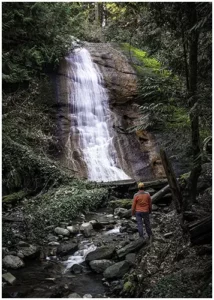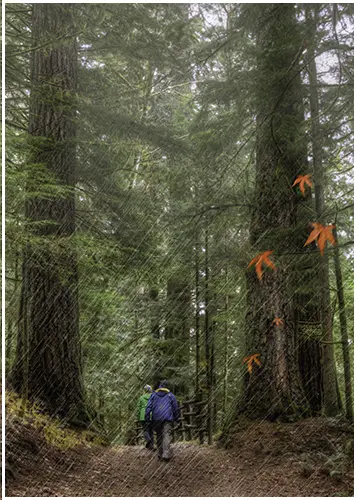
The Charming Northfield Falls in the Heart of Beach Estate Park
Looking to kill off an hour while in Nanaimo, BC? Just a short hop-skip and


Yay, it’s another winter here on Vancouver Island. What does that mean? The rain and winter storms are just around the corner. Most photo enthusiasts stay indoors during this time, but for me and the amazing people I shoot with, it’s the start of another storm season. If you are looking at a stormy sky and wondering if the rain has ruined your landscape photography plans, ponder no more! For me, the power of shooting in bad weather can reveal breathtaking scenes that clear skies simply cannot rival.
This article will help you learn how to shoot photos in extreme weather and use the challenging conditions to your advantage. Grey clouds on canvas can make for breathtaking images.
Don’t put your camera away when the sky darkens and the winds howl. These moments are perfect for landscape photography. Capture dramatic landscapes in stormy or foggy conditions to convey emotion and tell a compelling story that clear skies can’t.
Imagine thick fog, heavy rain, or a snowstorm—all these add moods that sunny days can’t match. Capturing the atmosphere tells stories of nature’s raw moments. As dark clouds approach a mountain, try and capture their intensity.
Landscape photography in extreme weather, like lightning storms or rainstorms, can be super rewarding! Here’s why: When nature gets intense, it adds drama and excitement to your photos. Lightning crackling across the sky or raindrops dancing on leaves make your shots stand out. Plus, extreme weather often means unique lighting and mood, which can give your images a wow factor. So, don’t shy away from bad weather; embrace it for stunning shots that’ll make your portfolio shine!
Embrace the weather’s impact on your landscape photography. Gloomy skies, howling winds, and cascading rain showers add a layer of emotion to your images. As a landscape photographer, use these elements to inject a strong mood into your work.
Think about the story you want to tell. Is it one of resilience in the face of an incoming storm or serenity within a gentle snowfall?
Focus closely on your subject and composition; this is what makes viewers feel like they’re part of the scene. Mastering the use of leading lines is an indispensable tip for shooting both indoors and outdoors. created by roads or branches to draw attention to the image. Look for contrasts in light and shadows that highlight textures and shapes made vivid by wet conditions.
Capturing mood in a photograph is not just about what you see but also about evoking feelings.
Finding good light in challenging weather can lead to dramatic and stirring lighting conditions. Stay alert and look for those brief moments when nature’s mood changes.
Look for the subtleties that bad weather brings to a landscape. Observe how the rain enhances the lustre of the foliage. Capture the patterns of snow or the way fog weaves through trees. Unique weather offers great photo opportunities. An element can turn a good photo into an amazing one.
Good light isn’t always about sunshine. In overcast conditions, you can get soft, diffused light that makes colours pop. Be alert for unexpected moments in nature, such as photographing lightning during a storm. Even a blind person can photograph lighting in a storm.
Don’t let grey skies fool you; even on dreary days, the light can appear (even briefly). Keep your eyes peeled for the moment when the sun peeks through the clouds. However, soft diffused light can bring out rich textures and hues that harsh sunlight might overpower.
Bad weather creates dramatic lighting. For example, take pictures of thunderstorms with lightning in the background or capture rainbows during dark showers. Use a waterproof camera or cover your gear with a plastic bag to capture these moments.
Use a tripod to keep it steady. Have you thought about trying long exposures to capture lightning during a thunderstorm? These tasks require a high level of accuracy and the ability to remain patient. This way, even when the weather seems uncooperative, you can unveil stunning landscapes hidden within the storm.
When you’re outside in strong winds and a dark sky, your camera’s shutter speed can reveal the hidden rhythm of poor weather.
Playing with shutter speed opens up a whole world of moods in your landscapes. Slow down the shutter, and you create a dreamy scene where water turns silky and clouds stretch across the sky. This ethereal effect can make even the gloomiest weather feel magical.
Pick up the pace with a fast shutter speed to capture photos of rain frozen in midair or leaves held still by a gust of wind. It’s all about motion and energy, making viewers feel like they’re right there at the moment. Just remember to always use a tripod for long exposures to keep your camera steady and prevent camera shake.
Shifting from experimenting with shutter speeds to securing your camera on a tripod is key to nailing those long exposures.
They hold your DSLR or mirrorless camera steady as you capture the sweep of clouds or smooth flow of water. Even in gusty winds, a sturdy tripod ensures sharp images. Shooting in inclement weather allows you to experiment with such aspects in your frame.
Remember to check your tripod’s stability before shooting. Plant it firmly on the ground and adjust the legs so they’re even. Utilize a remote control or a timer for added convenience.
With these steps, long exposures transform bad weather into breathtaking scenery with ease.
Don't let the weather rain on your parade. Embrace the elements and capture the beauty of a bad weather day. Make it a shoot to remember.
Pro-Tip
While you may believe that stormy skies pose a significant obstacle, employing the correct shooting techniques will allow you to master the composition necessary to elevate your photograph and capture beautiful images without vibrant sunsets, so be creative. Look for leading lines, use symmetry, and let nature’s raw drama be the focal point of your photos.
Bad weather brings clouds, fog, and rain that hide your scene. But don’t let this stop you! Instead, focus on creating a strong composition to tell a story. Think about leading lines from rivers or paths that pull the viewer’s eye through the picture. Use trees or rocks as natural frames for your landscape shots. With no stunning sunset colours, it’s what’s in your frame and where you place it that will grab the viewers’ attention. Play with foreground interest, maybe a leaf-laden branch or textured rock.
These elements add depth when the skies are grey and the light is flat. Work with what nature gives you and make compositions that stand out because of their structure, not just their colour.
During harsh weather conditions, it is essential to protect your camera equipment. To keep your gear dry, there are solutions like rain covers and moisture-absorbing silica packs. You can pick up an umbrella at a reasonable cost if it’s in your budget; there are even umbrella attachments for your tripod.
Protecting your camera gear is key; using the right camera bag and rain cover to shield your equipment is paramount. Weather-sealed bodies and lenses also offer more defence against wind, rain, and dust.
After a day of shooting, always clean your gear properly. This keeps it working well and ensures you get the best-quality photos every time.
Maintain your camera by checking for any damage or wear regularly during the shoot.
When braving poor weather conditions for a photo shoot, protecting yourself is as important as your camera gear. Wearing appropriate protective attire not only protects you from the weather conditions but also guarantees your safety and comfort. Invest in waterproof clothes, hiking boots, and warm gear to stay comfortable and avoid health risks in the rain, wind, or cold. Staying dry and warm is critical once you’re uncomfortable, your creativity suffers.
When the weather is bad, challenge yourself to pay attention to small things and focus on the details that others might overlook. Seek out a location where bad weather can actually work in your favour, adding depth and character to your shots. Observe the small details around you and find a strategic spot that embraces the weather’s moodiness to discover new captivating photos.
Bad weather doesn’t mean bad photos. Zoom in on tinier things, like leaves or frost patterns. Even when the sky is grey, these small wonders can make wonderful photos. They bring out the character of the area and tell a story all their own. With long lenses, you can capture these details without getting too close.
Focus on how raindrops hang from branches or how snowflakes stack neatly on surfaces. Use aperture to control the depth of field and highlight your subject against a soft background. By employing this approach, you are able to capture the allure of nature.
Picking the right spot is key when the weather isn’t perfect. You want a place that shows off nature’s drama when clouds roll in or rain starts to fall. Look for landscapes with strong shapes, like jagged cliffs or winding rivers.
Look for areas that tell a story. A lone tree bending in the wind can capture how wild it feels outside. Little things add depth to your photo and make viewers feel like they’re there with you, facing the elements.
Embracing the conditions, experimenting with exposures and compositions, and being mindful of the location can create unique and dramatic images. Bad weather doesn’t mean bad photos. The rain, wind, and clouds add a special mood to your story that sunny days can’t match. Dark skies and stormy moments often tell a stronger story.
Choosing where to shoot is key. Look for scenes that gain character from the weather: crashing waves during a storm or mist hanging over a mountain. Adjust your shutter speeds for creative effects: fast to freeze raindrops, slow to smooth out water motion.
Think about composition: with less light, shapes and lines matter even more to guide viewers through your photo. Embrace these elements and you might begin to enjoy shooting landscapes on cloudy days.
Absolutely! Photojournalists are able to capture breathtaking images even in the midst of rainfall. To successfully shoot photos in extreme weather, you need to embrace the dramatic mood that bad weather brings to landscapes.
A full-frame camera tends to be your best bet when dealing with challenging light and weather situations. The larger sensor can capture more light, improving the details in low-light conditions, such as in storms or overcast weather.
Indeed, the focal length is quite significant when shooting in the rain! Wide-angle lenses work wonders for capturing expansive landscapes and the dynamic skies that often accompany bad weather scenes.t
Get creative; use protective gear like rain covers or even simple plastic bags to shield your camera from the elements. It’s all about improvising; keep your gear dry so you can focus on snapping those moody shots without worry.

Looking to kill off an hour while in Nanaimo, BC? Just a short hop-skip and

Photography can be a fulfilling and enjoyable hobby that brings a creative outlet to your

Welcome to our guide to Photoshop tutorials for beginners: A Complete Beginner’s Tutorial for Learning